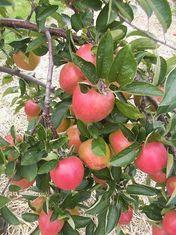
The postharvest unit at Writtle College has conducted an investigation into increased respiration rates with inoculation of Botryis cinerea in Braeburn apples.
Respiration is a vital biochemical process that occurs in all living cells. Post-harvest respiration is an irreversible process that begins straight after harvest, which slows when the temperature is lowered during cold storage. Measuring the respiration rate provides an invaluable source of information to determine produce conditions or to indicate problems on the storage life of the commodities in the long-term storage of regular cold storage systems. Determining the respiration rate could prevent disease in the cold store, while increasing the potential storage life of the produce.
The aim of this research is to investigate the effect of Botrytis cinerea on the respiration rate of apples stored at common temperature ranges encountered between harvest, consumer and retailer shelves (20°c) and in cold storage, or consumer home storage (5°c). This study also considered the respiration rate as a disease detection tool in apple storage.
Materials and Methods
The unit purchased Braeburn apples, grown in South Africa, at commercial maturity and transported them to the college. Randomly selected fruit were then divided into treatment groups and stored at an ‘ambient’ temperature (20°c) for 12 days and cold storage (5°c) for 5 days with 55 percent and 90+ percent RH respectively All samples were then inoculated with Botrytis cinerea, at a spore suspension of 9.6 x 10¬-3 spores.
The apples were wounded on a site close to the equator of the fruit and the exposed surface area of 10 mm diameter was subject to one of the following treatments: High Disease Pressure (0.5 ml of conidia of 96 x 10¬3), Medium Disease (0.02 of conidia of 96 x 103), Low Disease pressure (0.01 mil of conidia of 96 x 103), and Zero Disease Volumes (distilled water - control). Each sample was inoculated to a depth of 4mm from a 1ml syringe. All samples were placed at 20°c for two days until the first symptoms of the disease were observed. Upon observation of the disease, a sample from each treatment was placed in either 20°c with 55 percent or 5°c at 90 percent RH. After 11 days, the samples held at 5°c were transferred to 15°c in order to observe the effect on the respiration rates. Respiration rates were measured daily using David Bishop Combo 280 gas analysis equipment, with the infected tissue being scaled then separated and weighted at the end of the experiment.
Results and Discussion
The samples held at 20°c had the highest respiration rates at 11.001 mg CO2 kg-1 h-1 followed by the 15° and then the 5°c with a rate of 1.020 mg CO2 kg-1 h-1. Close analysis of the respiration rates shows that the infected samples had significantly (<0.05) increased rate from the second day until the end of the experiment. Disease was observed on the 5°c samples from day 6 onwards, with the diseased samples having an increased respiration rate from day 7, so disease was suppressed by the low temperature. Samples at 20°c and 15°c expressed disease, with subsequent deterioration of the apples, with ever increasing respiration rates throughout the remainder of the experiment. The rise in the respiration rate of samples at 5°c indicated the presence of disease, even in its early stages.
Both the temperature and amount of disease inoculated affected the respiration rate of the apples. In practice, low temperature storage will slow the respiration rate and prevent the disease development. Storage at 20°c increased the respiration rates, and assisted in the disease development in both inoculated and virgin apple tissue.
This experiment shows that apples that have been exposed to disease will require disinfection, as optimum storage temperatures alone did not prevent the development of the disease studied. Additionally apples that display a rising respiration rate may have been exposed to disease that cannot yet be observed to the naked eye.
Conclusion
The results show that during the cold storage of apples, the respiration rate can be used to monitor the possible disease pressure/exposure and the degree of infestation. The respiration data was found to be an accurate indicator of the physiological status and development of the stored apples compared to observation by the naked eye, which tends to be limited in scope.
During apple storage, the temperature, disease infestation and apple cultivar are important factors that directly influence the respiration rate, and consequently the shelf life of the fruit. Storage temperature will determine the respiration rate but more importantly, temperatures higher than the lowest optimum storage temperature will increase the development and sporelation of diseases. It is important to maintain the lowest recommended temperature for the cultivar throughout storage and the subsequent supply chain, as this study has shown that any exposure to raised temperatures will result in the potential for faster disease progression, with the inevitable sporelation and wastage/rejection of the produce by the retailer/consumer.



